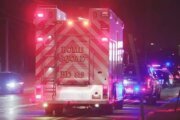RUNNING SPRINGS, Calif. (AP) — In the Southern California mountain town of Running Springs, residents live between two scenic lake resorts — a seemingly serene spot but one also caught between the swings of devastating winter snowstorms and menacing summer wildfires.
Niko Rynard is currently evacuated from his home due to the Line Fire, which has charred 58 square miles (150 square km) since the weekend.
About a year and a half ago, the director of the Running Springs Area Chamber of Commerce raced down the mountains during a break in the relentless snowfall his neighbors came to call “Snowmageddon.” Roads were blocked for days.
The 29-year-old, who moved to the area nine years ago from the East Coast, is now staying with friends nearby but said others are shelling out hundreds of dollars to cram into hotel rooms until it’s safe to return.
The blaze is one of three major wildfires that have ravaged the mountains east of Los Angeles, destroying dozens of homes and forcing the evacuations of thousands of people. While California is only now confronting the height of wildfire season, the state already has seen nearly three times as much acreage burn than during all of 2023.
Much of this, Rynard said, “comes with the territory” and is part of living in a beautiful area. He said long-time residents have told him the massive wildfires are cyclical, much like the snow.
To add to people’s rattled nerves, Southern California was rocked by a 4.7-magnitude earthquake Thursday morning.
Running Springs is dubbed the “gateway to the San Bernardino Mountains” and perched more than a mile high. The town was among the communities snowed in when a blizzard walloped the area in 2023. Now, the community has been doused with bright fire-red retardant to protect it.
“It can be tough to live in these environments,” said Dawn Rowe, a San Bernardino County supervisor whose district covers mountain communities. “It’s beautiful — a lot of people come to visit and they find they might want to relocate for one reason or another. I would encourage everybody to spend an amount of time doing their due diligence.”
The Line Fire is burning through dense vegetation that grew after two back-to-back wet winters that included snowstorms that caused tree branches to break, leaving behind a lot of “dead and down fuel,” said Cal Fire Operations Section Chief Jed Gaines. Another wildfire threatened the mountain community of Wrightwood about a 50-mile (80-kilometer) drive to the west.
The fires have threatened tens of thousands of homes and other structures across Southern California since they escalated during a triple-digit heat wave over the weekend. Cooler weather was helping firefighters slowly gain the upper hand in battling the blazes. No deaths have been reported, but at least a dozen people, mainly firefighters, have been treated for injuries, mostly heat-related, authorities said.
In one daring rescue caught on video, Cal Fire Riverside County Battalion Chief Mike Martinez saved a lone woman walking within feet of the Airport Fire in Orange County, driving his SUV up to the edge of the blistering flames so she could enter the vehicle.
“This is one of those moments … you hope you never come across,” he told the Los Angeles Times. “I’ve been doing this for almost 30 years. We’re used to extreme fire behavior but to see a civilian walking down the middle of the street was surreal.”
Jason Anderson, district attorney for San Bernardino County, said Thursday that nine arson-related charges have been filed against a suspect accused of starting the Line Fire.
“This is particularly galling in a community that unfortunately over the last couple of years has dealt with the scourge of wildfires,” he told reporters, adding that the suspect’s vehicle has been linked to three areas where fires were started.
The suspect is due to be arraigned in court on Friday.
The full extent of the damage caused by the wildfires remains unclear. The three blazes are:
— The Airport Fire in Orange County, which has burned more than 36 square miles (93 square kilometers). The fire was 5% contained Thursday morning and was reportedly sparked by workers using heavy equipment in the area. Ten firefighters and two residents were injured in the blaze, according to the Orange County Fire Authority. The fire has been difficult to tame because of the steep terrain and dry conditions — and because some areas hadn’t burned in decades.
— The Line Fire in the San Bernardino National Forest, which was 18% contained Thursday and has threatened more than 65,000 homes. The blaze has injured three firefighters.
— The Bridge Fire east of Los Angeles, which grew tenfold in a day and has burned 80 square miles (207 square km), torched at least 33 homes and six cabins and forced the evacuation of 10,000 people. The cause of the fire is not yet known. It remained zero percent contained Thursday.
In northern Nevada, the worst danger appears to have passed near Reno where a wildfire on the Sierra’s eastern front forced 20,000 evacuations over the weekend. The blaze closed all schools for four days and threatened to burn over the top of the mountains into the Lake Tahoe basin.
Part of the state highway from Reno to Tahoe remained closed Thursday. Authorities further relaxed evacuation orders after 600 firefighters held fire lines despite winds gusting up to 70 mph (112 kph) the day before and bolstered containment of the 9-square-mile (23-square-kilometer) Davis Fire, now estimated at 37%. Most of the 8,000 residents that began the day under evacuation orders were downgraded to evacuation warnings, allowing them to begin to return to their homes.
“All containment lines … are holding at this time,” Jason Clawson, an operations section chief for the federal firefighting team said at a briefing in Reno late Thursday. “Absolutely no concerns. We have crews, equipment, engines all spread out around the entire fire.”
___
Garcia reported from Wrightwood, California, Taxin from Santa Ana, California, and Rodriguez from San Francisco. Associated Press writers Scott Sonner in Reno, Nevada; Amy Hanson in Helena, Montana; Jaimie Ding in Los Angeles and Thomas Peipert in Denver contributed.
Copyright © 2025 The Associated Press. All rights reserved. This material may not be published, broadcast, written or redistributed.







